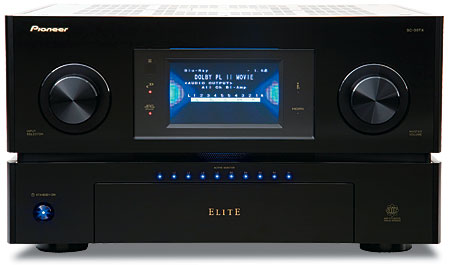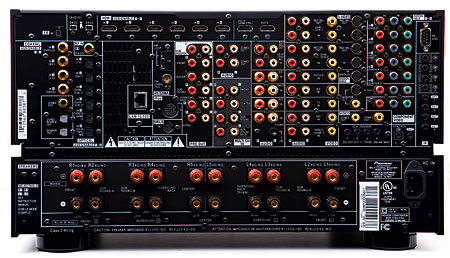Pioneer Elite SC-09TX A/V Receiver
 Price: $7,000 Highlights: Superb sound for both movies and music • 10 channels of powerful Class D amplification • Sets a steep learning curve but rewards with immense flexibility • Video processing has limitations, including no upconversion of HDMI sources
Price: $7,000 Highlights: Superb sound for both movies and music • 10 channels of powerful Class D amplification • Sets a steep learning curve but rewards with immense flexibility • Video processing has limitations, including no upconversion of HDMI sources
And the Kitchen Sink
Sometimes I get nostalgic for the early days of home theater. For example, I fondly remember the Proceed AVP processor I reviewed for Stereophile Guide to Home Theater in 1997. Conventional Dolby Digital and DTS were its most exotic operating modes, the remote had fewer than a dozen buttons, and it didn’t provide room equalization, extra surround modes, or onboard video processing. In fact, it didn’t have any video switching beyond S-video. We didn’t need no stinkin’ component, and no one had even heard of HDMI. Laserdisc was the most established source, DVD was brand new, and consumer high definition was still a mote in the FCC’s eye.

But now we have A/V receivers like the Pioneer Elite SC-09TX, that have more features than the giddiest gadget guru or befuddled reviewer can get his hands around. I’ll do my best to keep the review of this incredibly complex product from turning into a miniseries.
Don’t Toss That Manual
My first few weeks with the SC-09TX were relatively blissful. I did a manual setup and bypassed all of the automated and exotic features. I listened to music and movies with only the occasional annoyance (“Where is that &%#$@ front-panel dimmer control?!” and “Why is this &%$@# remote only partially backlit with dim, hard-to-read blue lighting?”).
You could do the same and use the receiver with increasing pleasure as you scope out its advanced features, one by one. Since this is a very complicated product, that will take time. The Pioneer is THX Ultra2 Plus certified and offers all the options and listening modes that heaven and THX allow. For this review, I stuck mostly to good old two-channel (with a subwoofer) for music, and unadorned 5.1-channel decoding for surround formats. I spent most of my movie time with HD material that had lossless or uncompressed audio (including Dolby TrueHD and DTS-HD Master Audio). The Pioneer decodes these formats from their bitstreams. It can also accept them as multichannel PCM if you choose to let your Blu-ray player decode them.
The receiver has 10 channels of amplification, each rated at 200 watts into 8 ohms (with seven channels driven). There’s only one practical way to squeeze so many powerful amp channels into a product like this. It would need to use the latest in highly efficient, Class D switching amplifiers, in this case from ICEpower. Pioneer calls its implementation of this technology Direct Energy High Fidelity Class D.
You can use the 10 amplifier channels in several ways, including biamping, using multiple zones, or placing up to 9.2 channels in the same room (with up to six surrounds). Oddly, Pioneer did not include a specific menu choice for a basic 5.1-channel setup. I simply selected the option for 5.2 channels, which is designed to biamp all five full-range channels. Then, I hooked up each speaker to just one of the two biamp outputs for each channel and used a single subwoofer. The SC-09TX was none the wiser.

The SC-09TX includes so many audio and video inputs and outputs that the specification page doesn’t give their numbers. The receiver will play vinyl LPs through its moving-magnet phono input, Dolby Digital audio on Laserdisc through its RF input, and XM and SIRIUS satellite radio (with optional tuners). It will also play audio and video from an iPod and play back photos and video through the receiver’s Home Media Gallery from your iPod, USB flash drive, or other storage device. You can also link to a home network via the Pioneer’s Ethernet port. In short, if the Pioneer doesn’t have enough connections for your system, you need to get out more.
The receiver cross-converts (transcodes) analog component, composite, and S-video to one another and to HDMI. But it can’t convert HDMI to analog video. The SC-09TX also features onboard Marvell video processing. (Go to www.marvell.com for more info, but don’t drop the last “l,” or you’ll be reading about Iron Man, Spider-Man, and the Hulk.) Unfortunately, with HDMI sources, the video is passthrough only, with video processing active only with component and lower forms of analog video life. The upconversion is limited to a maximum of 1080i, analog-video-to-analog-video. But it will upconvert to 1080p if you transcode an analog video input to an HDMI output.
The analog video processing offers its own video controls (Brightness, Contrast, Hue, Chroma Level, and Noise Reduction) and two optional aspect ratio settings. Unfortunately, these controls weren’t always accessible on my sample. Sometimes the controls were active, but other times they were inaccessible.
The Pioneer’s front-panel LCD screen displays the receiver’s menus or the actual source image (as a sort of preview monitor). It can also show the source image with the menus overlaid on top. But the front-panel screen cannot display an HDMI source.
The remote control is a sea of small buttons. Since it must perform a variety of operations, it’s designed well enough (apart from that dim blue backlighting). It also offers direct input selection. But I suspect that most SC-09TX installations will substitute a higher-end, user-friendly programmable touchscreen.
Setup: The Fun Begins
You can set up the Pioneer in several different ways. As I noted earlier, I spent most of my time with the Pioneer in a manual setup, which made me a happy camper. However, the SC-09TX’s manual doesn’t explain a manual setup until page 56.





























































